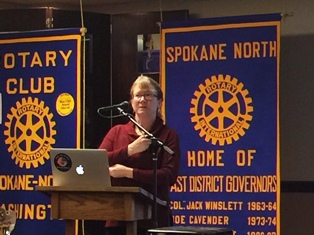Removing Snake Rive Dams - Sam Mace
Posted by Charles Rehberg on Nov 07, 2016
North Notes
Spokane North Rotary Club Bulletin
November 7, 2016
Briefly:
Hero helpers needed: Two volunteers are needed to help present Golden Hero awards Dec. 9 at 1:30pm at Holmes school. If interested, contact President Nancy Hanson or Sandy Fink.
Removing Snake River dams: a real fish story
A public hearing next week will give Spokane-area residents a chance to revisit the controversial issue of removing four hydroelectric dams from the Snake River.
Rotary-North members got a preview of one side of the conversation on Nov. 7. One point of agreement: it’s complicated.
The hearing is 4-7 p.m., Monday, Nov. 14 at The Historic Davenport Hotel. At issue: removing four dams upstream from the confluence of the Snake and Columbia rivers to the port of Lewiston, Idaho. The dams are Ice Harbor (completed in 1962), Lower Monument (1969), Little Goose (1970) and Lower Granite (1975). A proposed fifth dam at Asotin was never built.
Coalitions seeking to expand hydropower sources and inland shipping first proposed the dams in the 1930s. After completion, much eastern Washington wheat was barged to Portland and turbines powered enough electricity for 800,000 homes a year, up to 5 percent of the region’s power.
Now a competing coalition, including sportsmen’s groups, clean energy groups and Indian tribes, wants the dams removed. U.S. District Court Judge Michael Simon in May rejected another (the fifth) federal plan to mitigate, among other things, occurences like the death of 250,000 wild salmon in the river system in 2015.
One main culprit, linked to global climate change, was 70 days of unseasonably hot temperatures in both the Columbia and the Snake rivers.
 Making the case for fish at the club luncheon was Sam Mace, Inland Northwest director for Save or Wild Salmon (SOS). The organization for 15 years has advocated dam removal to save salmon and steelhead.
Making the case for fish at the club luncheon was Sam Mace, Inland Northwest director for Save or Wild Salmon (SOS). The organization for 15 years has advocated dam removal to save salmon and steelhead. Part of “complicated”: the Bonneville Power Administration has said removal of the Snake dams would require building a natural gas-fired power plant, emissions from which, it claims, would be like putting 421,000 more vehicles on the region’s roadways. Mace said the hydropower is only “2 to 4 percent” of the region’s load and use of “renewables” (wind, solar), plus “efficiency” would make building another power plant unnecessary.
Mace said public comment – Spokane’s hearing is one of 15 in the region – will be taken until late January. A new federal plan and a decision on dam removal may be 5 years away.
“Eight dams are too many,” Mace told the club. She said fish may navigate the four lower Columbia dams, but adding four more on the Snake is too much. Hauling fish around the dams in trucks is not a good alternative, she said.
Mace said the four lower Columbia dams “provide economic benefits, including flood control, irrigation and hydropower,” far more than the lower Snake dams.
Mace and others cite the Elwha River revival following removal in the last five years of the Glines Canyon and Elwha dams west of Port Angeles on the Olympic peninsula. Fish counts rose dramatically there, she said.
“In the Columbia-Snake system, there are 140 miles of rivers and 5,000 miles of the best intact habitat,” Mace said, adding that the cool, alpine streams of remote central Idaho offer ideal homes for sockeye salmon.
A new factor “in the conversation,” Mace said, is “the Orca issue.” Puget Sound whales feed on Columbia River salmon. The recent death of an Orca mother and calf from malnutrition got wide media coverage in western Washington.
While the lower Snake dams were built when large aluminum smelters needed massive amounts of energy and barge fees made some river shipping more competitive than rail, those conditions have changed.
The Port of Portland has lost its last tenant and rail alternatives for container shipping from Puget ports are more competitive, Mace said.
Yet another issue Mace notes is the accumulating silt behind Lower Granite dam, which may require raising river levees in Lewiston and Clarkston, an unpopular alternative.
The bulletin producers:
Bulletin editors: Chuck Rehberg and Sandy Fink
Photo: Sandy Fink
